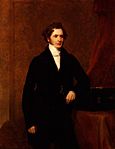1847 United Kingdom general election facts for kids
|
|||||||||||||||||||||||||||||||||||||||||||||
|
|
|||||||||||||||||||||||||||||||||||||||||||||
|
All 656 seats in the House of Commons 329 seats needed for a majority |
|||||||||||||||||||||||||||||||||||||||||||||
|---|---|---|---|---|---|---|---|---|---|---|---|---|---|---|---|---|---|---|---|---|---|---|---|---|---|---|---|---|---|---|---|---|---|---|---|---|---|---|---|---|---|---|---|---|---|
|
|||||||||||||||||||||||||||||||||||||||||||||
|
|||||||||||||||||||||||||||||||||||||||||||||
The 1847 United Kingdom general election was a major event where people across the UK voted for their representatives in the House of Commons. It took place between July 29 and August 26, 1847. Even though candidates calling themselves Conservatives won the most seats, the Whig party remained in control of the government.
Contents
Understanding the 1847 Election
This election was important because it showed a split within the Conservative Party. They were divided into two main groups. One group was called the Protectionists, led by Lord Stanley. The other group supported free trade and were known as Liberal Conservatives or Peelites. Their leader was the former Prime Minister, Sir Robert Peel.
This split meant that even with more seats, the Conservatives couldn't form a strong government. This allowed the Whigs, led by Prime Minister Lord John Russell, to continue leading the country.
Who Was Running?
Several political groups took part in the election. The main ones were the Whigs and the Conservatives.
- The Whigs were led by Lord John Russell. He was already the Prime Minister before the election.
- The Conservative Party was split. Their official leader was Lord Stanley. However, the Peelites, a part of the Conservative party, had different ideas.
- The Repeal Association was an Irish group. They wanted to end the Act of Union between Great Britain and Ireland. Their leader was John O'Connell.
- The Chartists were a working-class movement. They pushed for political reforms, like allowing all men to vote.
Key Results and What They Meant
The election results showed that the Whigs, even though they won fewer seats than the combined Conservative groups, had enough support to stay in power.
| Party | Seats | Gains | Losses | Net gain/loss | Seats % | Votes % | Votes | +/− | |
|---|---|---|---|---|---|---|---|---|---|
| Whig | 292 | +21 | 44.51 | 53.75 | 259,311 | +6.9 | |||
| Conservative | 325 | −42 | 49.54 | 42.59 | 205,481 | −8.2 | |||
| Repeal Association | 36 | +16 | 5.49 | 2.93 | 14,128 | +1.0 | |||
| Chartist | 1 | 1 | 0 | +1 | 0.15 | 0.59 | 2,848 | 0 | |
| Irish Confederation | 2 | 2 | 0 | +2 | 0.30 | 0.14 | 661 | N/A | |
How People Voted
This chart shows the percentage of votes each main party received.
| Popular vote | ||||
|---|---|---|---|---|
| Whig | 53.75% | |||
| Conservative | 42.59% | |||
| Irish Repeal | 2.93% | |||
| Chartist | 0.59% | |||
| Others | 0.14% | |||
How Seats Were Won
This chart shows how many seats each party won in Parliament.
| Parliamentary seats | ||||
|---|---|---|---|---|
| Whig | 44.51% | |||
| Conservative | 49.54% | |||
| Irish Repeal | 5.49% | |||
| Chartist | 0.15% | |||
| Others | 0.3% | |||
Important Firsts and Changes
The 1847 election had some notable moments:
- The Irish Repeal group gained more seats than in the previous election.
- The Chartists won their only seat ever in Parliament. This was for Nottingham's second seat, and the winner was the Chartist leader Feargus O'Connor.
- Britain elected its first Jewish Member of Parliament (MP), Lionel de Rothschild. He was a Liberal and won a seat in the City of London. However, at that time, MPs had to swear a Christian Oath of Allegiance. This meant Rothschild could not officially take his seat until a new law, the Jews Relief Act, was passed in 1858.
- The constituency of Sudbury, which used to elect two members, was not allowed to vote in this election. This is why there were two fewer seats in the House of Commons compared to the election before.
Images for kids





